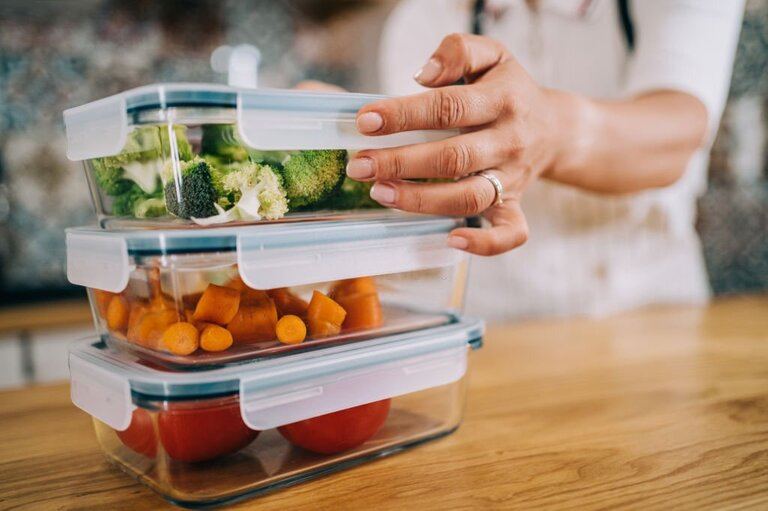Food storage is something that everyone does all the time. This way, you can keep the food for a few weeks longer. It not only helps to store food but also acts as a form of insurance for the family. Minimize spending on unnecessary food, and save time cooking at home after a busy day. So let's find out some benefits of food storage!
1. Increase the shelf life

When you preserve food with any food preservation method that works for them, that food automatically lasts for a long time. Like when buying pepper to make a stew, the rest is usually air-dried for future use if I don't want to grind them in a blender. This helps to reduce the risk that may be caused by microbial pathogens.
Furthermore, food preservation is very important in controlling microbial pathogens that can be harmful to humans when eaten with food items.
2. Prevent rapid spoilage of food items

A form of food preservation that involves partial or permanent inhibition or destruction of microbial growth, ensuring that your food doesn't spoil quickly.
3. Food preservation to ensure that food is available all year round

Not only does it store a few days, but it also makes the food usable for a whole year. However, this only applies to certain foods, some food items can't grow in some environments or some seasons, please store and store them quickly, they will be useful for consumption when the time comes.
4. Preservation so that it can be transported long distances

There will be certain foods at your location that can't grow there or foods that are perishable, so they are usually preserved and stored in containers and then shipped to the area. your area to consume.
Some foods can be shipped long distances from country to country. An Asian country like Saudi Arabia can ship food items like packaged dates to an African country like Nigeria for consumption.
5. Always have convenience foods available

Often microorganisms have a way of alternating food flavors, but a well-preserved food is safe from microbial activity. This makes food items more convenient for consumption.
6. Make sure to neutralize the anti-nutritional factors

Food preservation actively inactivated anti-nutritional factors can degrade the nutrients of foods or destroy them and render them inedible.
7. Methods of food preservation:
Traditional method

Used a variety of food preservation methods for chefs from the dawn of agriculture to this time of the industrial revolution.
Cooling

Several personal and commercial refrigerators have improved diets, especially in the Western world, by safely storing foods such as fresh fruit, salads, and dairy products for long periods. and only do this process when the weather is warm.
Before mechanical refrigeration, you can chill foods in the form of an icebox or a tuber cellar. By using cut ice, the townspeople depended on the ice trade.
On the other hand, some methods of culturing stem cells more than any other form of preservation for different purposes are valuable to them; local food, traditional home cooking steps, family farming, and more.
Healing
The earliest curing form is in dehydrated or dried form. It was used as early as 12.00BC. Smoked and salted are other improved methods of the drying process, and the addition of antibacterial agents makes food easier to preserve.
Aspiration products often deposit some pyrolysis products such as phenol, syringol, guaiacol, and catechol. As for salt, it helps to speed up the drying process through the use of osmosis and then hinders the growth of common bacterial strains. More recently, nitrites have been discovered and used to cure meat from spoiling, and subsequently give it its characteristic pink color.
Freezing
Freezing is also a popular traditional food preservation method used domestically or commercially. This is a method of preserving many foods such as prepared foods without freezing them in an uncooked state.
Boiling
Boiling is a traditional food preservation method, done by boiling the liquid to kill the bacteria present in it; Milk and water are often boiled to kill harmful microorganisms that may reside in them.
Heating
Heat a food substance to a temperature that kills microorganisms commonly found in stews and dairy before storing.
8. Some modern method
Pasteurization
The process involved in the preservation of liquid foods. It's to combat the acidity of local wines.
Today, it applies to dairy foods. As if you are storing milk using this method, heat the milk at about 70°C for 15 to 30 seconds to remove any existing bacteria, and then lower the heat to 10°C to inhibit bacterial growth. remaining bacteria. Store milk in a sterilized bottle or bag in a cold place or place in a home or restaurant. This method was discovered by Louis Pasteur, a French chemist in 1862.
Vacuum packing

This is the process of preserving food in a vacuum environment such as in an airtight bag or bottle.
Because the vacuum helps remove the oxygen that bacteria depend on to survive. Vacuum packaging is used to preserve foods such as nuts to reduce flavor loss due to oxidation.
Preservative food additives

These are also some antibacterial substances that can prevent the growth of bacteria or fungi including antioxidants such as oxygen absorbers, which hinder the development of oxidation of food ingredients.
Common antimicrobial preservatives include calcium propionate, sodium nitrate, sodium nitrite, and sulfite.
9. Three types of food
Several different preservation methods for the three foods:
Perishable food

Includes plenty of raw fruits and vegetables as well as, for those who eat them, meat, milk, and eggs. Cooked foods are perishable more easily. To preserve these foods for a long time, perishable foods are stored at refrigerator or freezer temperature. If refrigerated, many perishable foods could be used within 3-7 days (less for many animal products).
Semi Perishable food
Depending on how they are stored and handled, they spoil quickly or can extend their shelf life. Flour, grain products, dried fruit, and dry mixes are the most perishable. If stored and handled optimally, like in a clean, vacuum-sealed bag, perishable food can remain intact for six months to a year.
Pinned or non-perishable food

Some dried beans, condiments, and canned goods are non-perishable foods. Even when they are stored in ideal conditions, they can begin to degrade over time.
Several factors affect the shelf life of food
With perishable and semi-perishable foods, the general rule is that if you can't use them in time, they should be stored or preserved.
The nature of foods like strawberries can degrade in as little as a day, potatoes can last for months when stored properly.
Ripeness and freshness of food. This partly depends on where it was grown and how long it took to ship. Even if you just bought it from a grocery store, it may have been recently harvested… or not.
The interval and the previous holding temperature when you bought it.
The temperature of the food storage area, whether it's the refrigerator, freezer, countertop, pantry, or basement.
Humidity in food storage areas can vary greatly depending on where in your home and where you live.
The type of container or packaging where food is preserved, such as glass, plastic, foil, or fabrics.
Some food preservation facilities include those used for dry goods, or canning, food dehydration, pickling, handling, and more. As follows:
- Kitchen
- Larder
- Root cellar
- Fully specialized food preservation facilities include:
- Cool store (large cold room or building)
- Cool storage (a very large cold building)
- Silo (used to store grains, like wheat and corn)
- 2800 Polar Way (world's largest food freezer)
Conclusion
Through the benefits of food storage that have been mentioned above, it is crucial to preserve foods so that they do not spoil easily. The method of reheating cooked rice prevents microbial activities from interacting with it.
There are many different methods of food preservation today, both traditional and modern methods play an important role in ensuring food availability throughout the year.














